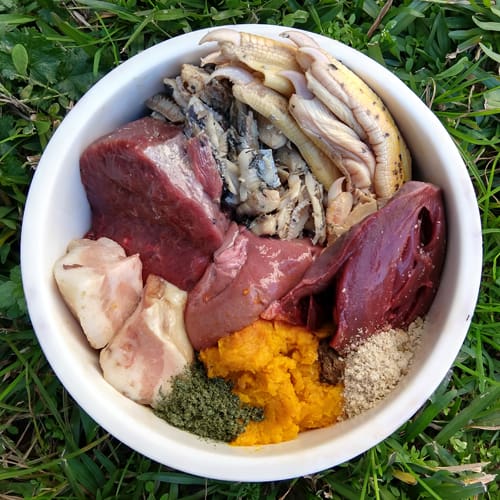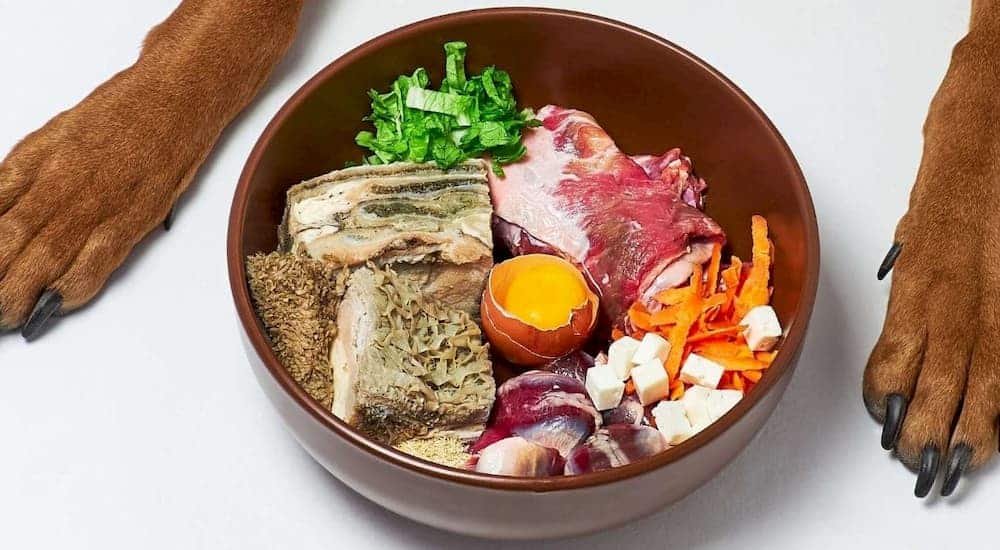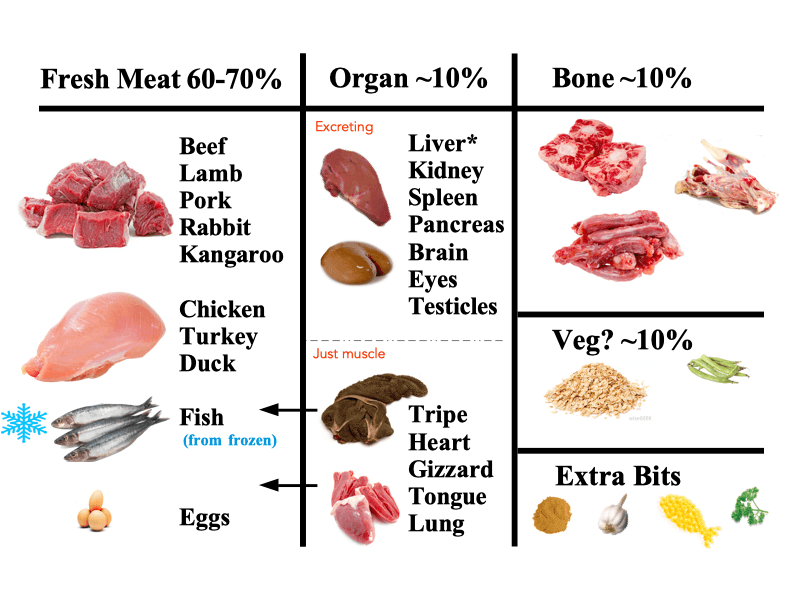Raw food can be beneficial for dogs, offering essential nutrients and promoting a healthy coat. However, it also poses risks, such as bacterial contamination and nutritional imbalances.
Raw food diets for dogs have gained popularity among pet owners seeking natural options. Advocates argue that raw diets mimic a dog's ancestral eating habits, leading to improved health. Proponents claim benefits like enhanced digestion, shinier coats, and increased energy levels.
Despite these claims, it’s crucial to consider the potential risks involved. Bacterial infections and unbalanced nutrition can harm your dog. Consulting a veterinarian before switching to a raw diet ensures your pet receives adequate nutrients. Understanding both the advantages and disadvantages of raw food can help you make an informed decision for your furry friend.
Introduction To Raw Food Diets For Dogs
The raw food diet for dogs has gained much attention. Many dog owners are curious about it. This diet emphasizes feeding dogs raw meat, bones, and vegetables. Advocates believe it mimics a dog's natural diet. Critics raise concerns about nutrition and safety.
The Basics Of A Raw Food Regimen
A raw food diet typically includes:
- Raw meat: Beef, chicken, lamb, or fish.
- Raw bones: Meaty bones for chewing.
- Organs: Liver, kidneys, and other organs.
- Fruits and vegetables: Carrots, apples, and greens.
Each ingredient plays a crucial role in a dog’s health. Raw meat provides protein. Bones contribute calcium. Organs supply essential vitamins. Fruits and vegetables add fiber and antioxidants.
Popularity And Controversies
The raw food diet is popular among many dog owners. They believe it leads to:
- Shinier coats
- Improved digestion
- More energy
Despite its popularity, some controversies exist:
- Health risks: Raw meat may contain harmful bacteria.
- Diet balance: Nutritional deficiencies can occur.
- Veterinary concerns: Some vets advise against raw diets.
Understanding these aspects is vital for making informed choices. A balanced diet is essential for your dog’s health.

Customize Homemade Dog Food
Historical Perspective On Canine Diets
Understanding the history of canine diets helps us grasp their nutritional needs. Dogs have evolved alongside humans for thousands of years. Their diets have changed significantly during this time.
From Wild Ancestors To Domestic Pets
Dogs descended from wolves, which are natural hunters. Their wild ancestors primarily ate:
- Meat from prey
- Fruits and vegetables
- Small bones and organs
As wolves adapted to life with humans, their diets began to change. Early humans provided scraps and leftovers. This led to a more varied diet for early dogs.
Evolution Of Dog Feeding Practices
The way we feed dogs has transformed over centuries. Here are some key milestones:
- Prehistoric: Dogs relied on natural hunting and scavenging.
- Agricultural Era: Humans began sharing food scraps.
- Industrial Age: Commercial dog food emerged in the late 1800s.
- Modern Day: Raw and holistic diets gain popularity.
This evolution reflects changes in human lifestyles and our understanding of nutrition.
Today, many dog owners explore raw food diets. They seek to replicate the natural diet of wild canines.
Components Of A Raw Food Diet
A raw food diet for dogs focuses on natural, uncooked ingredients. This diet includes a variety of components. Understanding these components helps in deciding if this diet suits your dog.
Meat, Bones, And Organs
The foundation of a raw food diet is high-quality protein sources. These include:
- Muscle meat: Provides essential amino acids.
- Organ meat: Rich in vitamins and minerals.
- Raw bones: Good for dental health and calcium.
Common meats used are chicken, beef, and lamb. Organs like liver and kidney are also beneficial. Raw bones should be large enough for safe chewing.
Fruits, Vegetables, And Supplements
Fruits and vegetables add important nutrients. They provide fiber and antioxidants. Some beneficial options are:
- Carrots: Great for vision and dental health.
- Spinach: Packed with vitamins A, C, and K.
- Blueberries: High in antioxidants.
Supplements can enhance a raw diet. Consider adding:
- Fish oil: Supports skin and coat health.
- Probiotics: Aids digestion.
- Vitamin E: A powerful antioxidant.
Always consult a vet before making changes. They can help create a balanced diet plan.
.webp?width=792&height=1633&name=best-fruits-veggies-raw-food%20(1).webp)
Customize Homemade Dog Food
Potential Benefits Of Raw Feeding
Raw feeding can offer several benefits for your dog. Many pet owners report positive changes in their dogs' health. Here are some of the key advantages.
Improved Coat Condition
A raw food diet can lead to a shinier and healthier coat. Here are some reasons why:
- Natural oils: Raw diets provide essential fatty acids.
- Better hydration: Fresh meat contains more moisture.
- Fewer allergens: Natural ingredients reduce allergy risks.
Many owners notice a decrease in shedding and itchiness. A vibrant coat often indicates overall health.
Dental Health Advantages
Feeding raw food can promote better dental hygiene. Some benefits include:
- Natural chewing: Raw bones help clean teeth.
- Less plaque: Chewing reduces tartar build-up.
- Fresher breath: Raw diets can minimize bad odors.
Regular chewing on raw bones strengthens gums. Healthy teeth lead to fewer vet visits.
Digestive System Benefits
A raw food diet can support your dog's digestive health. Consider these benefits:
- Natural enzymes: Raw foods contain digestive enzymes.
- Balanced pH: Raw diets help maintain stomach acidity.
- Better nutrient absorption: Fresh foods improve digestion.
Many dogs experience fewer gastrointestinal issues. A healthy gut can lead to increased energy levels.
Risks And Concerns
Raw food diets for dogs come with certain risks. Understanding these concerns is crucial for pet owners. Below are the main risks associated with feeding raw food to dogs.
Bacterial Contamination
Raw food can harbor harmful bacteria. Common bacteria include:
- Salmonella
- E. coli
- Campylobacter
These bacteria can cause serious illness in dogs and humans. Symptoms may include:
- Vomiting
- Diarrhea
- Fever
Always handle raw food with care. Wash hands and surfaces thoroughly after preparation.
Nutritional Imbalances
Raw diets can lead to nutritional deficiencies. Dogs need a balanced diet for health. Key nutrients include:
| Nutrient | Sources |
|---|---|
| Protein | Meat, fish |
| Vitamins | Fruits, vegetables |
| Minerals | Bone meal, supplements |
Consult a veterinarian before starting a raw diet. They can help ensure balanced nutrition.
Choking Hazards
Raw food may pose choking risks. Some common choking hazards include:
- Large bones
- Whole fish
- Uncut fruits and vegetables
Cut food into manageable pieces. Always supervise your dog during meals. This can prevent choking incidents.
Myths Vs. Facts
Many dog owners wonder about the benefits of a raw food diet. Several myths surround this topic. Understanding the difference between myth and fact can help dog owners make informed choices.
Debunking Common Misconceptions
Several misconceptions exist about raw diets for dogs. Here are some key myths:
- Myth 1: Raw food is dangerous and unhealthy.
- Myth 2: Dogs need grains in their diet.
- Myth 3: Raw diets cause aggression in dogs.
These beliefs often stem from fear rather than science. Many dogs thrive on a raw food diet.
Scientific Evidence On Raw Diets
Research shows that raw diets can be beneficial. Here are some facts:
| Benefit | Description |
|---|---|
| Improved coat condition | Many dogs show shinier, healthier fur. |
| Better digestion | Raw diets can lead to less gas and better stools. |
| Higher energy levels | Dogs may have more energy on a raw diet. |
Studies indicate that raw diets can support overall health. Always consult a vet before switching diets.
Transitioning Your Dog To A Raw Diet
Changing your dog's diet to a raw food regimen requires careful planning. This shift can boost their health and vitality. Follow a structured approach for the best results.
Step-by-step Guide
- Consult Your Vet
- Discuss the raw diet benefits.
- Check for any health concerns.
- Choose Quality Ingredients
- Look for fresh, high-quality meat.
- Include bones and organs for nutrition.
- Start Slowly
- Begin with 10% raw food mixed with current diet.
- Gradually increase raw food over 7-10 days.
- Monitor Their Response
- Watch for changes in energy levels.
- Check for any digestive issues.
- Adjust Portions
- Tailor food portions based on your dog's weight.
- Use a scale for accuracy.
Monitoring Your Dog's Health During Transition
Monitoring your dog's health is essential. Watch for any signs of discomfort or distress. Keep a close eye on their stool consistency and behavior.
| Signs to Monitor | What They Indicate |
|---|---|
| Loose stools | Possible dietary adjustment needed |
| Vomiting | Food may not agree with them |
| Increased energy | Positive response to raw diet |
Take advice from Pet Expert Dr Marty
ESA Pet is an online service that helps you get a legitimate ESA letter
Pet vitamin supplements and grooming products
Make notes of any changes. Share this information with your vet. This helps in fine-tuning your dog's diet.
Real-life Success Stories And Critiques
The debate over raw food diets for dogs includes many real-life stories. Pet owners share their experiences. Some praise the diet, while others voice concerns. Both sides provide valuable insights.
Testimonials From Pet Owners
Many pet owners report positive changes after switching to raw diets. Here are some of their testimonials:
- Sarah, a Golden Retriever owner: “My dog has more energy and a shiny coat!”
- Mike, a Dachshund lover: “He no longer has allergies since going raw.”
- Emily, a Beagle parent: “My dog loves the taste. He finishes every meal!”
These stories highlight notable improvements:
| Owner | Dog Breed | Reported Benefit |
|---|---|---|
| Sarah | Golden Retriever | More energy and shiny coat |
| Mike | Dachshund | No more allergies |
| Emily | Beagle | Loves the taste |
Critics' Viewpoints
Not everyone supports raw food diets for dogs. Critics present various concerns:
- Health risks: Raw diets can lead to bacterial infections.
- Imbalanced nutrition: Dogs may miss essential nutrients.
- Cost: Raw feeding can be more expensive than kibble.
Experts often emphasize the need for balanced diets. They recommend consulting a vet before making changes.
Pet owners must weigh both sides. Personal experiences help shape opinions. Finding the right diet for your dog is crucial.
Conclusion: Weighing The Pros And Cons
Deciding on a raw food diet for dogs involves careful thought. Understanding both benefits and drawbacks helps pet owners make the best choice.
Making An Informed Decision
Raw food diets can be beneficial. They may improve coat health and energy levels. Yet, risks exist. Some dogs may get sick from bacteria in raw meat.
- Benefits:
- Improved digestion.
- Better skin and coat.
- Increased energy.
- Drawbacks:
- Risk of bacterial infections.
- Nutritional imbalances.
- Costly and time-consuming to prepare.
Consulting With Veterinarians
Before switching diets, talk to a vet. They can provide valuable insights and advice. A vet can help assess your dog's health.
Ask about:
- Your dog’s specific dietary needs.
- Potential health risks associated with raw food.
- How to balance the diet properly.
Regular check-ups can ensure your dog stays healthy. Monitoring their health is essential when changing diets.
| Aspect | Raw Food | Commercial Dog Food |
|---|---|---|
| Cost | Higher initial costs | More affordable options available |
| Nutrition | Requires careful planning | Formulated for balanced nutrition |
| Digestibility | May improve digestion | Varies by brand |
| Convenience | Time-consuming to prepare | Ready to serve |

Customize Homemade Dog Food
Frequently Asked Questions About Is Raw Food Actually Good for Dogs?
Is Raw Food Safe For Dogs?
Raw food can be safe for dogs if prepared correctly. Ensure you use high-quality ingredients and follow proper hygiene practices. Consult your veterinarian for specific dietary needs and potential risks. Some dogs thrive on raw diets, but monitoring health is essential.
What Are The Benefits Of A Raw Food Diet?
A raw food diet can provide numerous benefits, including improved coat condition and enhanced digestion. Many pet owners report increased energy levels and healthier teeth. Additionally, raw food can promote better weight management in dogs. Always research and consult your vet before transitioning.
Can Raw Food Cause Health Issues In Dogs?
Yes, raw food can cause health issues if not balanced properly. Risks include bacterial contamination and nutritional deficiencies. Certain ingredients may also lead to allergies or gastrointestinal upset. Regular veterinary check-ups are crucial to ensure your dog remains healthy on a raw diet.
How Do I Transition My Dog To Raw Food?
Transitioning your dog to raw food should be gradual. Start by mixing raw food with their current diet. Slowly increase the raw portion while decreasing the kibble. Monitor your dog's response and adjust accordingly. Patience is key during this transition for a smooth adjustment.
Customize Homemade Dog Food
Conclusion
Raw food diets for dogs can offer benefits like improved coat health and increased energy. However, they also pose risks, including bacterial infections and nutritional imbalances. Always consult your veterinarian before making dietary changes. A balanced diet is essential for your dog's overall well-being and longevity.
Choose wisely for your furry friend.














